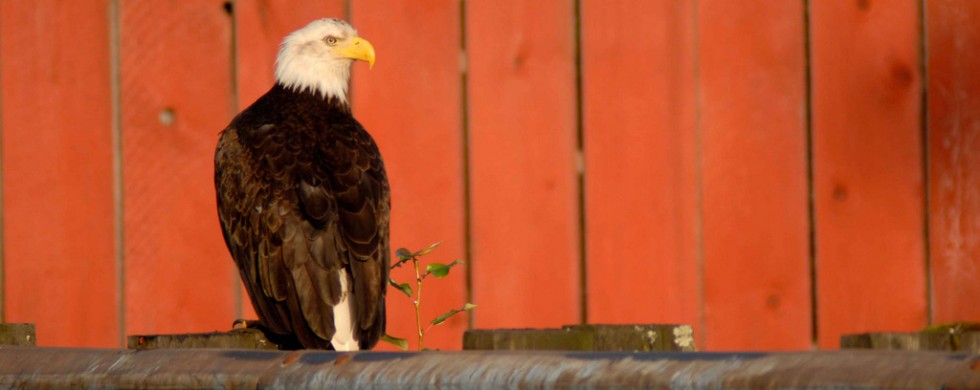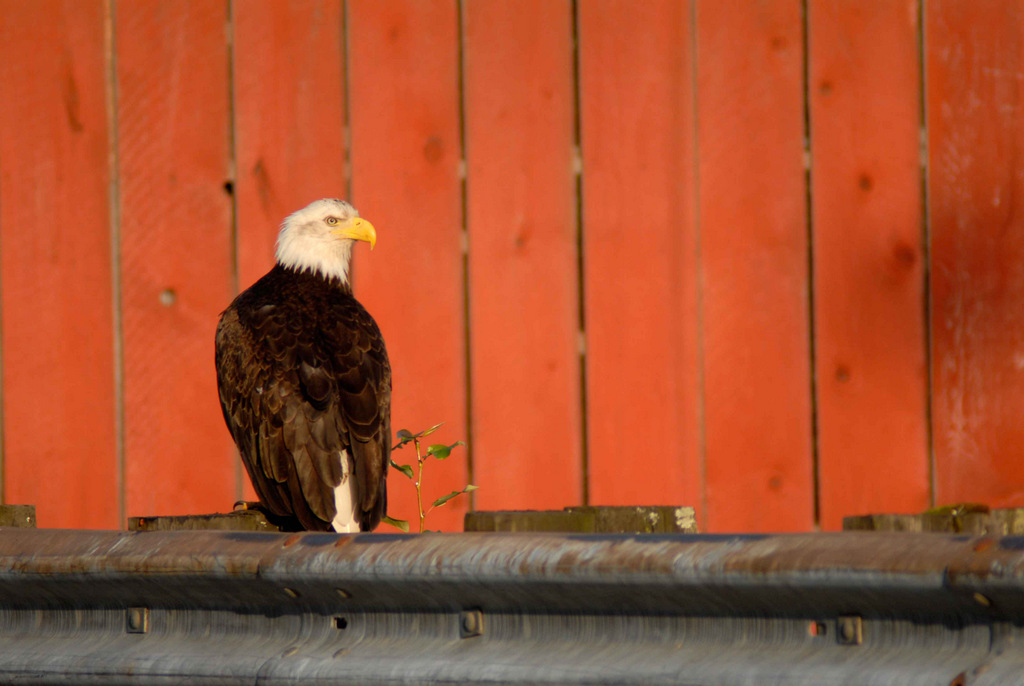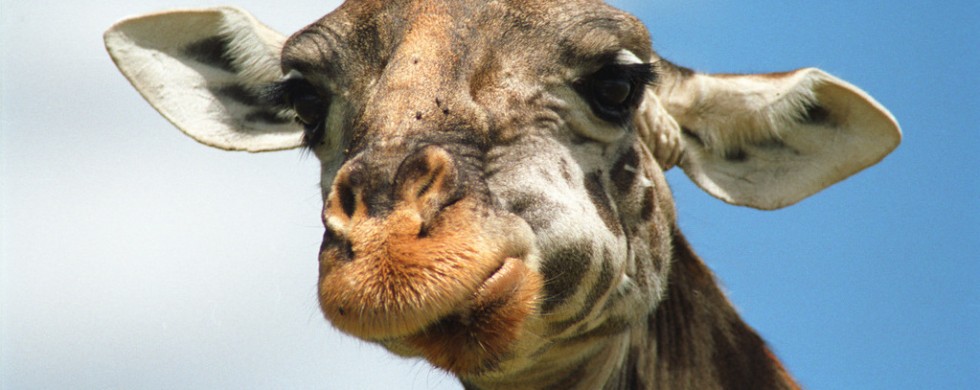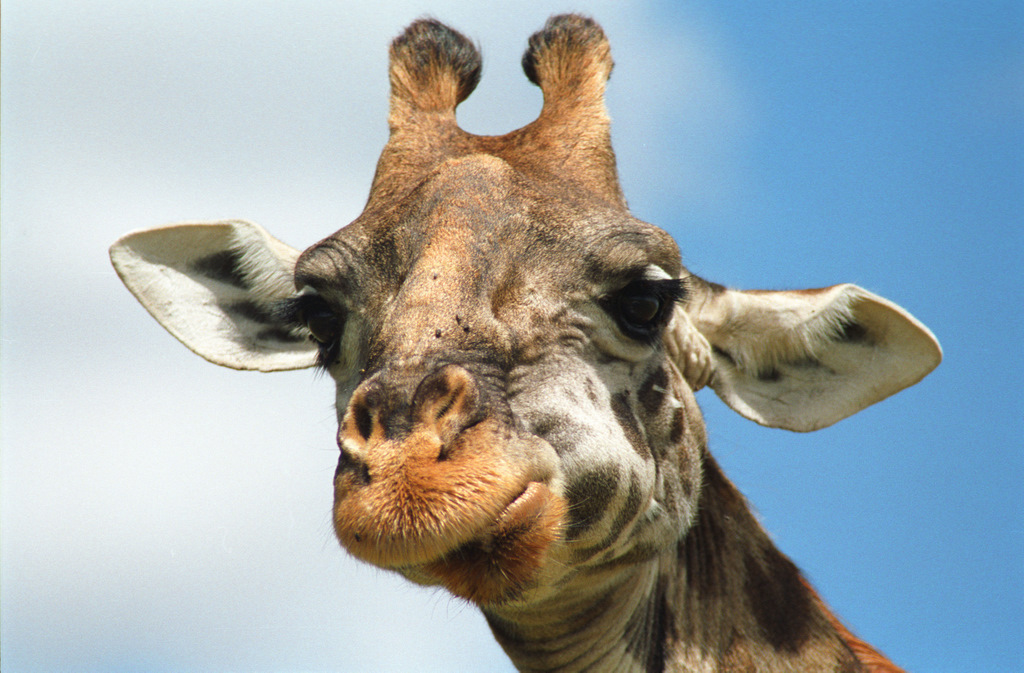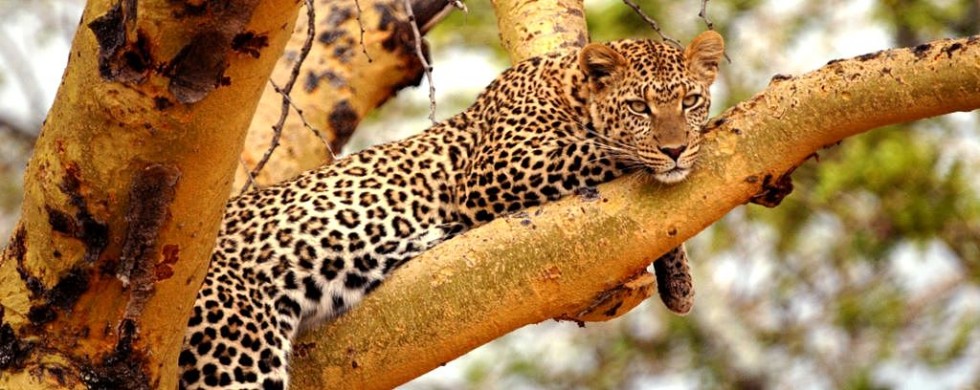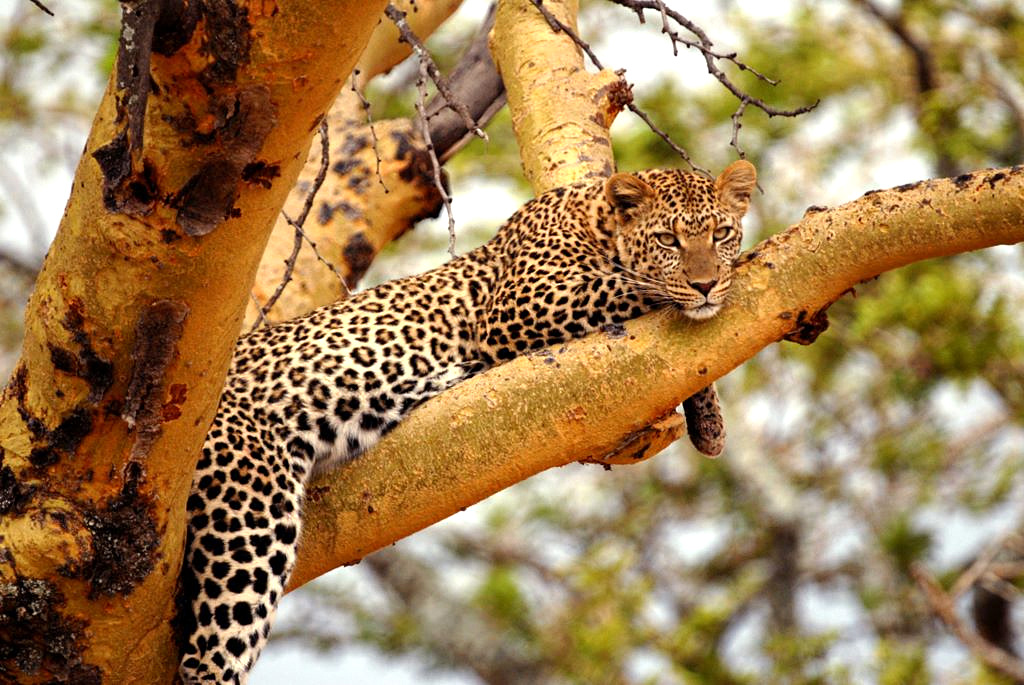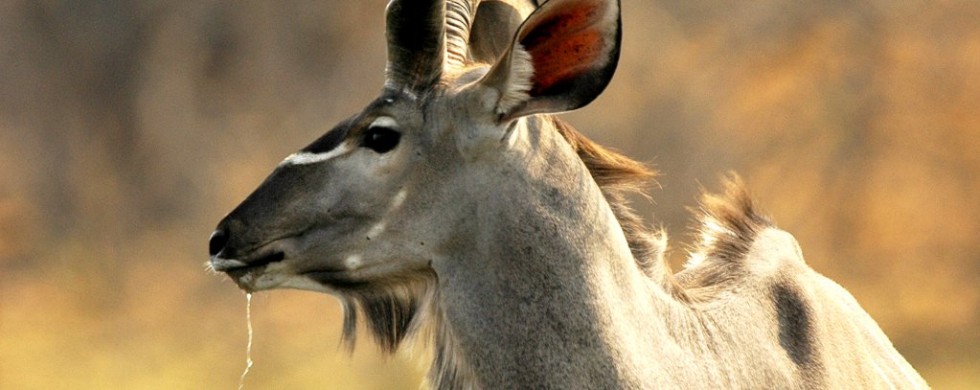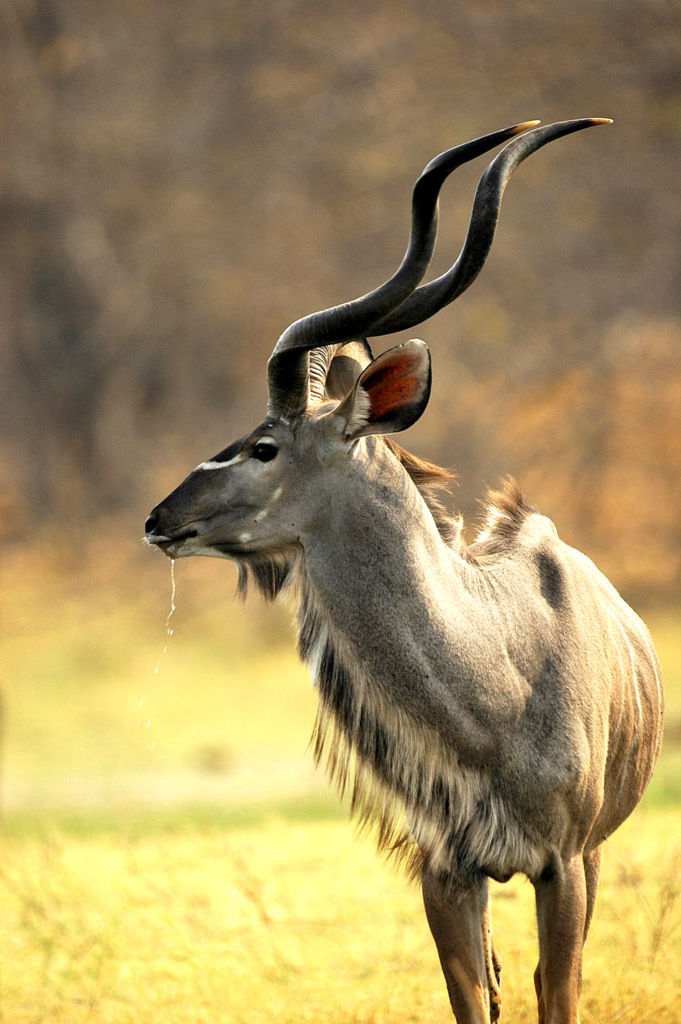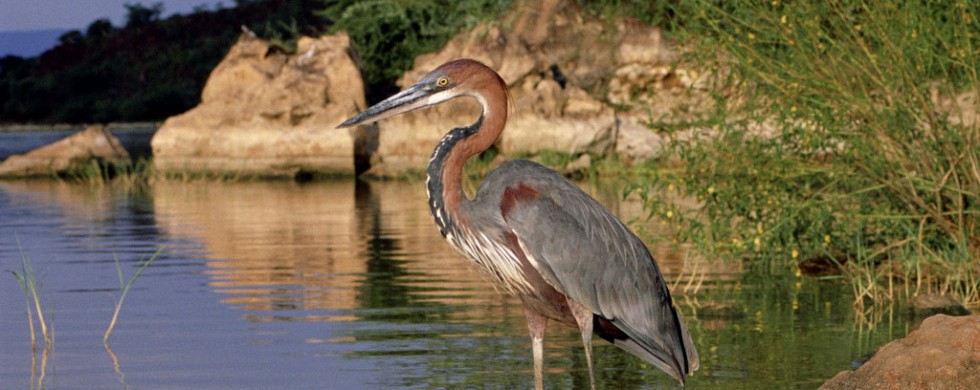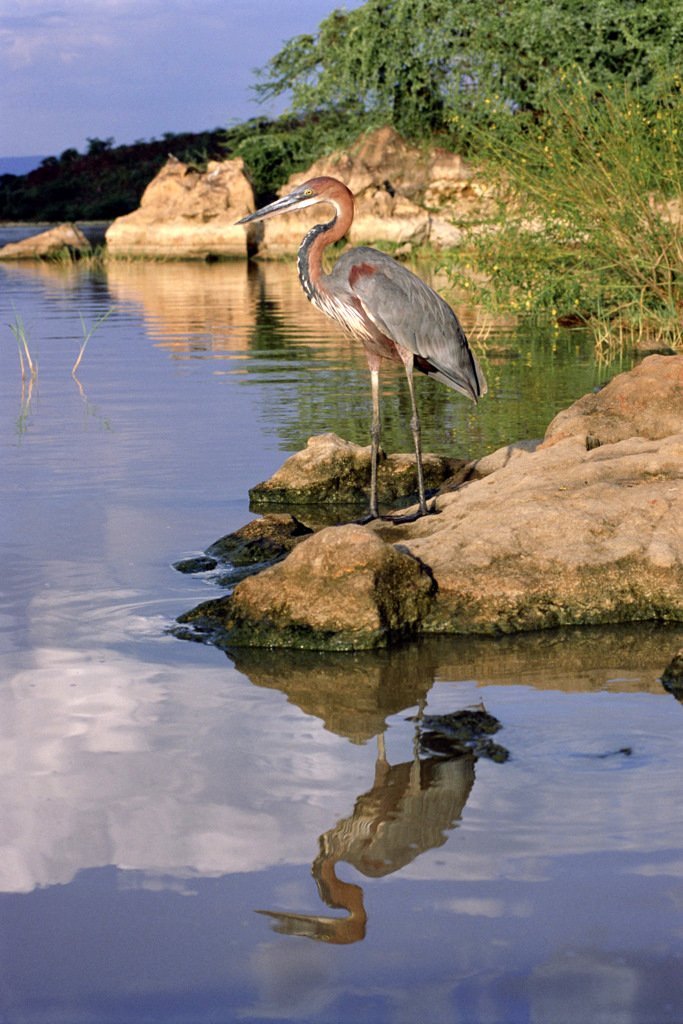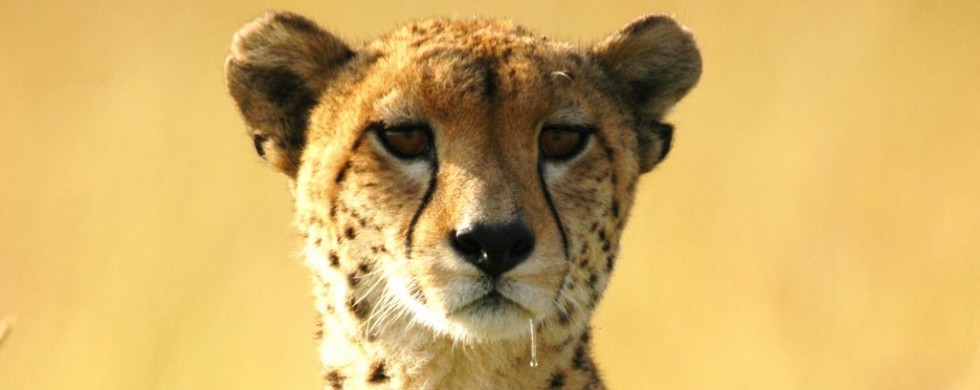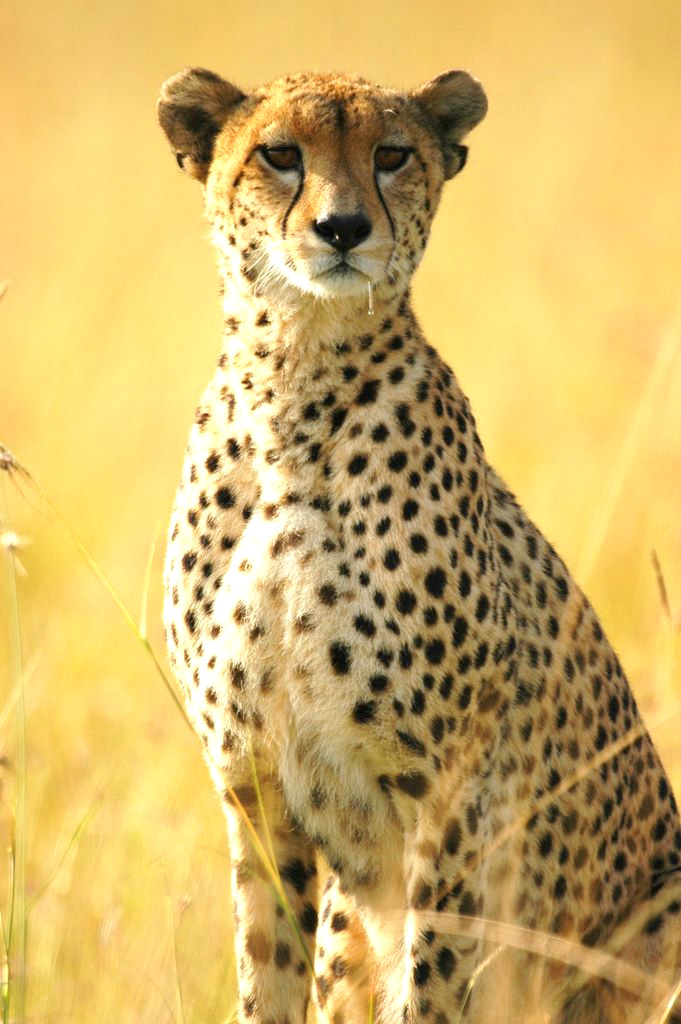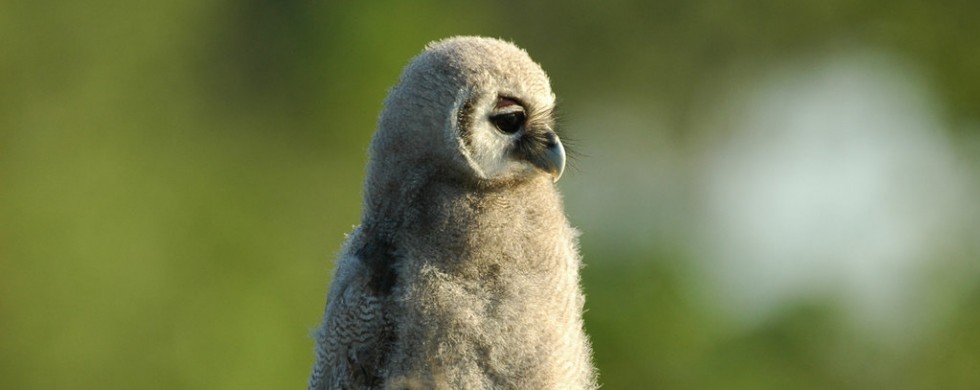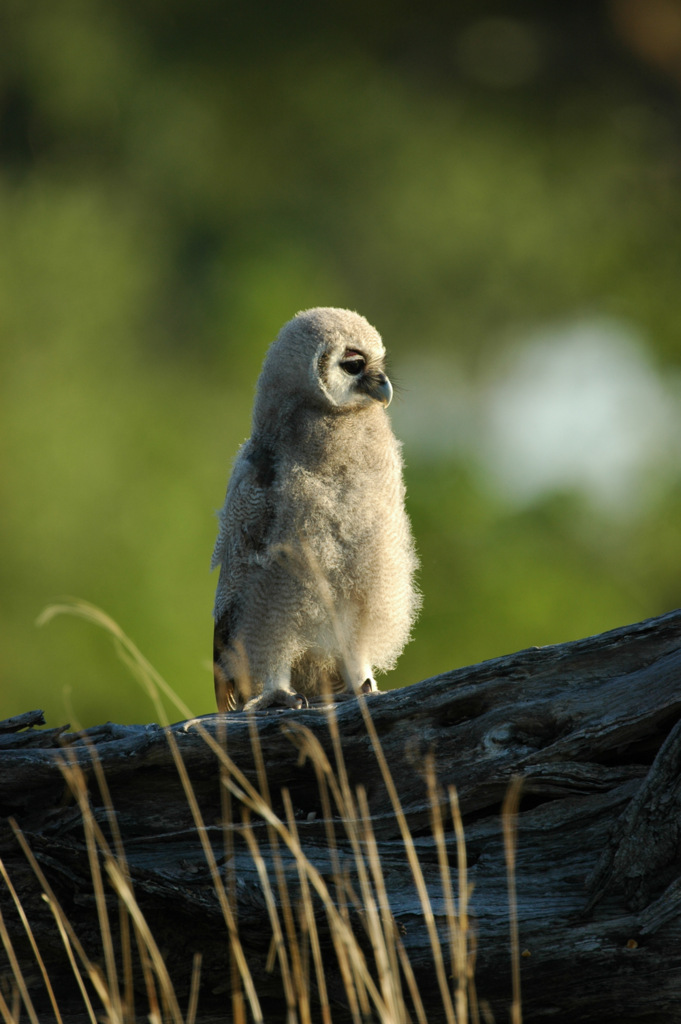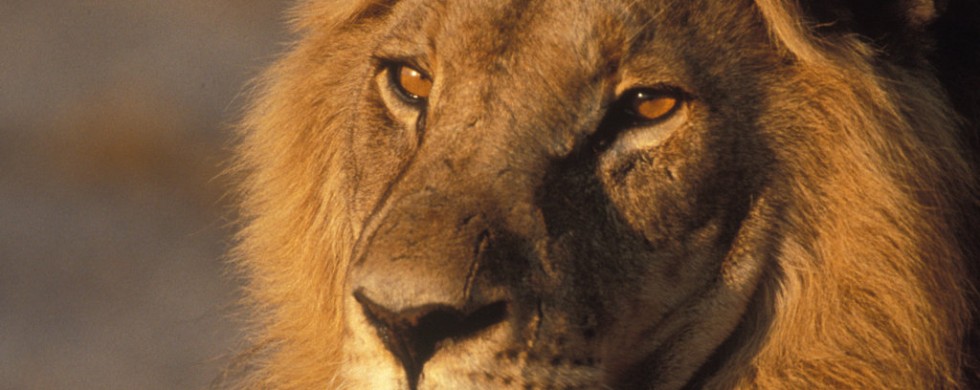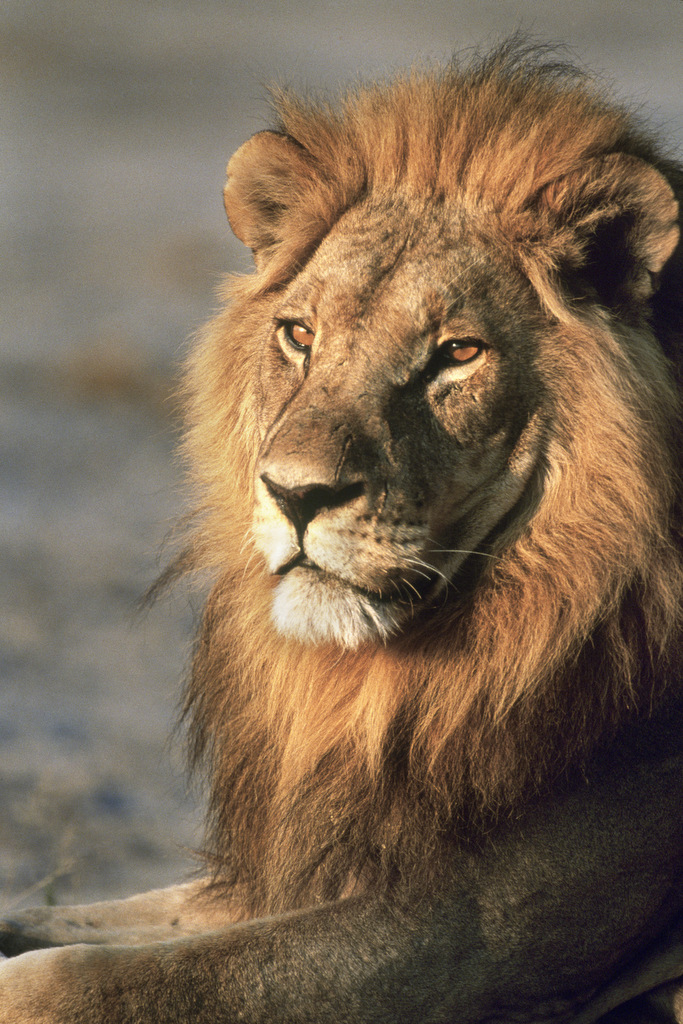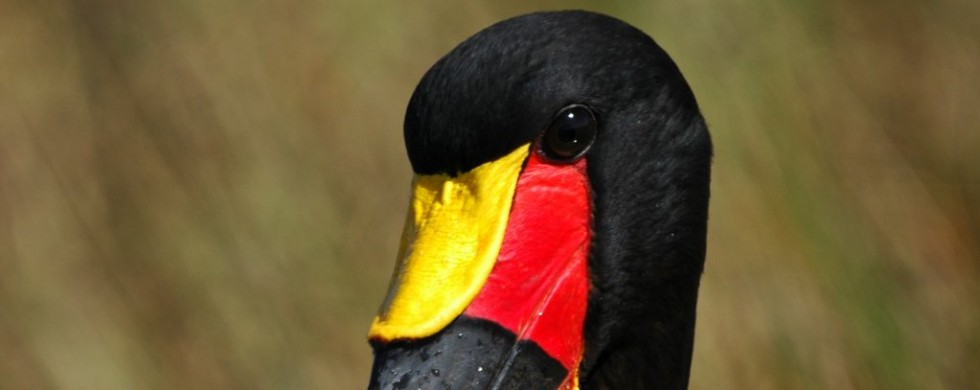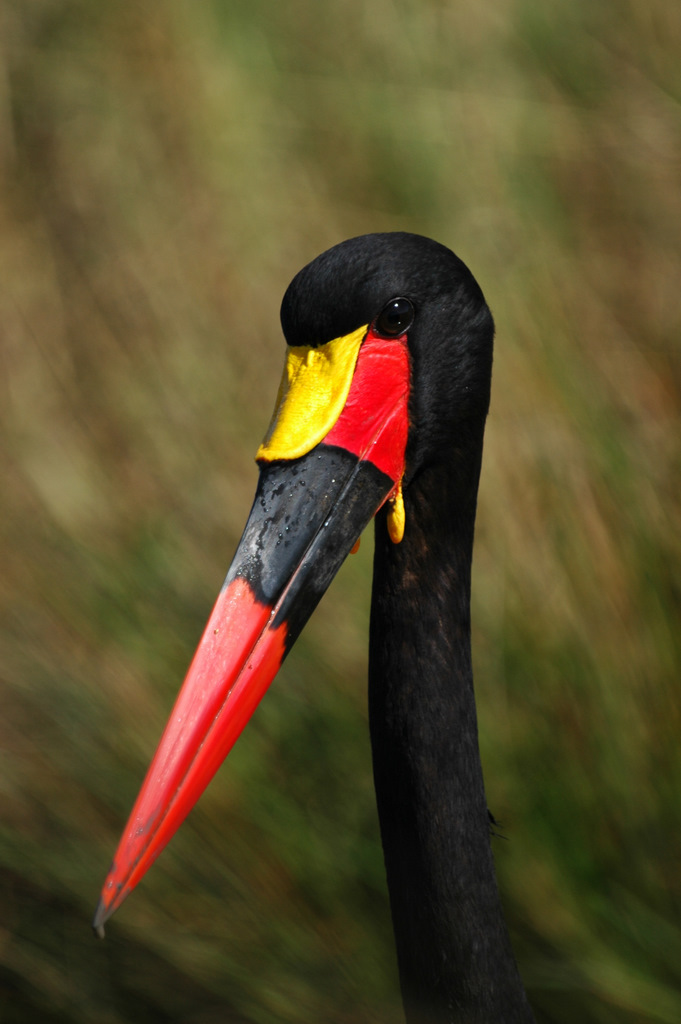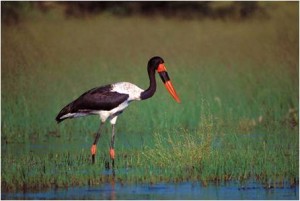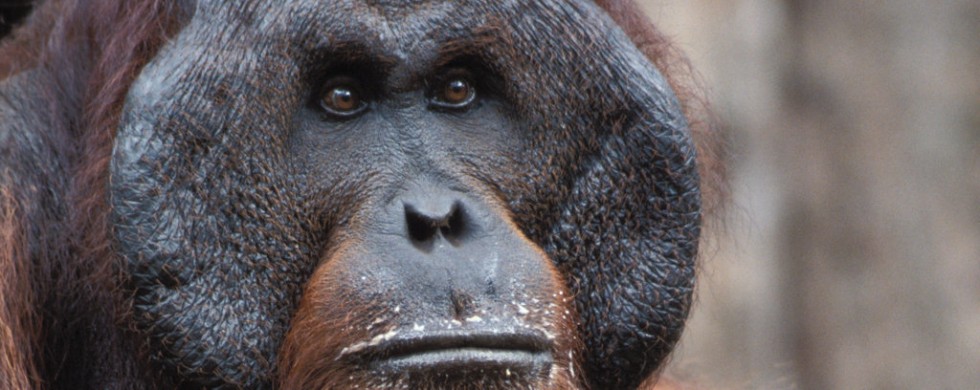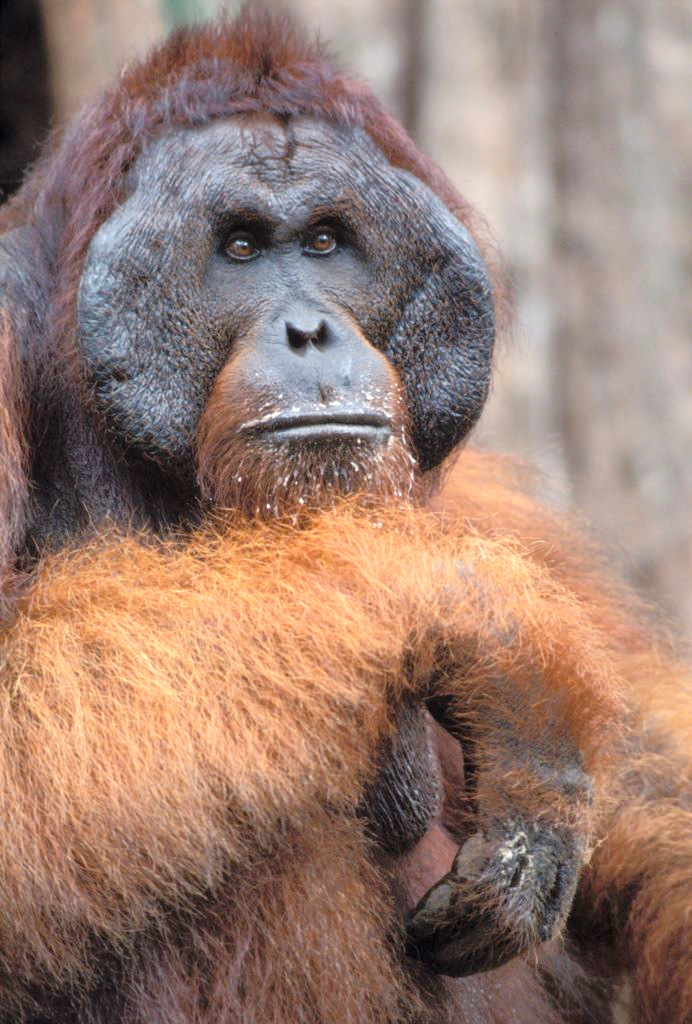04
Shot of the Month – July 2010
I traveled to Alaska in the summer of 2009 with the goal of capturing a nice shot of a humpback whale. Eight of our twelve days in the state would be spent exploring the Inside Passage on a 60-foot boat in a constant search for the massive beasts. We spent 15 hours a day chasing whale flukes (fluke = tail, for you land lovers), traversing coves, dodging icebergs, combing islands, and navigating remote fjords in search of whales and other wildlife. I shot over 11,000 photos during the trip.
Yet, in spite of all those miles and thousands of exposures, one of my favorite shots from the journey was captured about 50 yards from our Bed & Breakfast in the town of Petersburg, the port of call for the boat we would be using in the days to come. On our very first morning, perhaps thirty seconds after we left our lodging we came across this beautiful bald eagle beside the road.
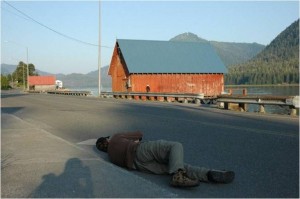 As you can see here, getting the shot required getting low – on a road. Fortunately, it was pretty early on a Sunday morning so traffic was light. My partner was supposed to be on the lookout for cars to ensure that I didn’t get run over. She obviously was not fully engaged in her primary directive.
As you can see here, getting the shot required getting low – on a road. Fortunately, it was pretty early on a Sunday morning so traffic was light. My partner was supposed to be on the lookout for cars to ensure that I didn’t get run over. She obviously was not fully engaged in her primary directive.
In some parts of Alaska seeing a bald eagle is about as exotic as seeing a robin, i.e. they are everywhere. The bald eagle has always thrived in Alaska and of the 70,000 eagles estimated to exist today over half of them live in this northern state. Bald Eagles can be found in all of the lower 48 states and some live year-round in the states along the East and West Coast, the Rocky Mountains, and the Mississippi River. Other bald eagles will migrate from Canada into the remaining U.S. states during the winter months.
Michael’s life lessons from this trip:
- While it is always good to have a goal in life to provide some general direction the happiest people in this world are those who are able to seize and appreciate what life offers along the way. I was drawn to Alaska to photograph whales but came away with a lovely shot of an American icon.
- Get up early and keep your eyes open, the greatest treasure may be just next door.
- No risk, no reward. (but use a spotter).
Until next month…:-)
15
Shot of the Month – June 2010
Last month I talked about the leopard. This month we will discuss the camelopard — the 14th-century term used by the English for 500 years for the creature we know as the giraffe. In fact, the scientific name for the giraffe, camelopardalis, comes from the early Roman name for the beast that they thought resembled a cross between a camel (general size and look) and a leopard (the spotting).
Giraffe Fun Facts:
Funny Looking Cows: Did you know that giraffes were the largest ruminants in the world? Yep, just like cows, giraffes have four stomachs and they regurgitate each mouthful several times to process it. Giraffes can often be seen chewing their cud, just like Bessie the cow on your local farm.
Neck and Neck: The six-foot neck found on your typical giraffe helps make it the tallest mammal in the world. You might imagine that they have quite a few vertebrae to keep that neck going but like all mammals, including us, they only have seven vertebrae in their neck. Seven very e-l-o-n-g-a-t-e-d vertebrae!
Big-Hearted: Literally. Pushing blood up that lengthy neck requires a powerful pump. The giraffe’s heart weighs 22 pounds and is about 2 feet long.
That First Step is a Doozy: Mother giraffes give birth standing up so newborns fall six feet, head first, to the ground. Ouch.
We Need a Bigger Crib: At birth, giraffes are 6 feet tall.
Light Sleepers: Giraffes require the least sleep of any mammal and on a given day they doze a maximum of 2 hours and may sleep as little as 10 minutes in a 24-hour period. Periods of sleep rarely last longer than five minutes at a time. Yes, they do sit on the ground to do this, resting their head on their rump.
Big Eaters: Giraffes prefer the leaves and twigs of Acacia trees. When times are good they can eat 65 pounds of the stuff in a day. If water is plentiful giraffes can drink 10 gallons at a time. When water is scarce, giraffes can go for long periods without water due to the high water content of acacia leaves.
Just Plain Big: Male giraffes can reach 18 feet in height (meaning he can look in your second-story window without stretching) and can weigh from 1,800 to 4,300 pounds. The females stand 13 to 15 feet in height and can weigh 1,200 to 2,600 pounds.
Kiss at your Peril: Giraffes have tongues that are 18 inches long to help reach far away leaves and twigs.
Cute but Deadly: The giraffe has six-foot-long legs with saucer-plate size hooves that deliver a kick that can crush the skull of a lion.
Ok, now you have all the basics on our favorite even-toed ungulate, the star previously known as camelopard.
15
Shot of the Month – May 2010
Although it is the smallest of the “Big Cats”, the leopard, shown here, may be the most successful of the group. Informally, the “big cats” are the four members of the genus Panthera and include the tiger, the lion, the jaguar, and the leopard.
Fun fact for your next party conversation: These are the only four cats that can roar.
The leopard is the ultimate survivor and is highly adaptable. Leopards have the widest distribution of any big cat and can live in jungles, woodlands, and open savannahs in sub-Saharan Africa, northeast Africa, Central Asia, India, and China. Leopards are so adaptable they are even found in the temperate forests in the Russian Far East where they endure temperatures as low as -13° F in the winter. Although rarely seen scientists believe that the global leopard population may be greater than the population of lions and cheetahs combined. Despite their relative success, most leopard populations outside of Africa are endangered due to loss of habitat.
Leopards prefer mid-size antelope as their main food source, though depending on the situation, they can survive on dung beetles, monkeys, rodents, reptiles, birds, fish, and well, you get the idea, just about anything they can catch. Correspondingly, leopard size can vary greatly depending on the nature of its diet. Males are typically 30% larger than females and can weigh from 65 to 200 pounds. Females can weigh from 50 to 130 pounds.
Leopards are the decathlon athletes of the natural world: they can reach speeds of 36 mph, have a vertical leap of 10 feet, have a horizontal leap of more than 20 feet, and are strong swimmers. Their primary hunting style is based on stealth as they move quietly through the bush and pounce on prey from a short distance. They also hunt from trees surprising their prey from above. Leopards are very muscular and pound for pound are the strongest of any cat. A leopard can carry prey 3x times its body weight into a tree.
As you can see, the diminutive leopard is in many regards the biggest of the big cats…
15
Shot of the Month – April 2010
What can weigh up to 600 pounds and has a mane?
No, try again. The male lion only weighs up to 400 pounds.
The picture is a big clue. It is the Greater Kudu.
Believe it or not, these massive antelopes are only the 2nd largest antelopes in the world. For those of you keeping score at home the largest antelope is the Eland, weighing in at up to 1,500 pounds. But that is a story for another month.
Greater Kudu can be found across a wide range of Africa. In the east, they live in Ethiopia, Tanzania, Eritrea, and Kenya. In the south, they live in Zambia, Angola, Namibia, Zimbabwe, South Africa, and in Botswana, where this photo was taken.
Kudus prefer to live in thick, wooded areas, rocky hillsides, dry river beds, and areas with lots of water. Turns out that kudu are vulnerable on the open plains as they do not run very fast and they do not have much stamina — ergo with nowhere to hide they can be easily run down by lions, leopards, and wild dogs. However, among the thick bush kudu have a better chance of success. Despite their size, kudu are excellent jumpers and a male can easily leap 8 feet or more (Picture a 600 lb antelope jumping clean over your head with a couple of feet to spare!) When pursued they simply leap over rocks and bushes that predators have a hard time navigating. And for the kudu, the best defense is a good offense, of sorts. Amongst the thick vegetation, their colorations and markings make them very difficult to see – so if they remain perfectly still they can often go undetected by carnivores on the prowl.
Despite their wide range kudu numbers are declining. Much of their habitat is disappearing as humans cut down the forests to make farmland. Hunting is also a big problem as trophy hunters prize those amazing cork-screw horns that are found only on males. At full maturity, the horns make a complete 2 ½ twist.
Alas, if humanity continues its relentless encroachment the kudu will soon have no place left to hide, and then, ironically, we will truly never see them again.
15
Shot of the Month – February 2010
Ok, you guessed it, this month we are going to talk about cheetahs. This is a glamour shot of a healthy cheetah that I found on the plains of Kenya, Africa. The allure is a bit dampened by that bit of drool, uh, just there, yeah, there on the right. At the time of this shot the cheetah and I were surrounded by thousands of zebra –perhaps this fellow was contemplating the dining bonanza before us.
Attacking an adult zebra is a daydream at best. Adult zebra can weigh from 450 to 1,000 lbs – far outside the weight class of our speedy cat. A full-grown cheetah weighs from 80 to 140 lbs and focuses on smaller prey that usually weighs less than 90 lbs often preferring Thomson’s Gazelle, Grant’s Gazelle, springbok, or the Impala. On a good day, a cheetah might go after a baby zebra or wildebeest.
No creature in the world can run as fast – cheetahs can reach speeds of 75 mph in 3 seconds flat and can cover 24 feet in a single stride. That means a cheetah can accelerate faster than any Ferrari, Porsche, or Lamborghini made today.
Virtually every aspect of the cheetah’s body has been transformed to maximize speed. They have a slender, long-legged torso very similar to that of a greyhound dog. They have semi-retractable claws – claws that cannot be fully withdrawn. The claws are therefore always in contact with the ground ensuring excellent traction acting much like a good set of track cleats. Cheetahs have large nostrils to improve oxygen intake and they have an enlarged heart, liver, and lungs to efficiently circulate oxygen throughout the body. They have small heads to lower wind resistance. An unusually flexible spine acts like a giant spring that can produce explosive surges of speed and long strides. Black “tear marks” that run from the inside corner of each eye down the side of the nose help reduce glare from the sun and improve vision (think football players with black makeup on their cheeks). Finally, cheetahs have especially long tails which act like rudders that enable them to make exceptionally sharp turns and outflank fleeing prey.
Basically, a cheetah is a supercar on paws. But so many words…. as they say, a picture is worth a thousand of ‘em…
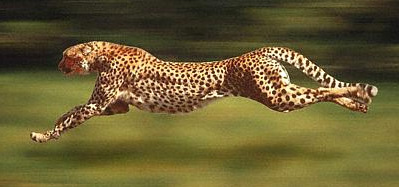 (Source)
(Source)
Now. That’s. Fast.
Until next month…:-)
15
Shot of the Month – January 2010
After only a few minutes into our morning game drive, we drove around a sharp corner and as we cleared the bend my guide slammed on the brakes. In front of us, we were startled to find a young, seemingly mesmerized owl standing on a large log.
It was like a scene out of a fairy tale. The air was cool and the morning air fresh, but still. The owl’s fuzzy down feathers were softly lit as the sun just began to rise over the horizon. The fledgling stared forward as if in deep thought or reflection.
While obviously still young, this owl was BIG. After a moment of taking this all in the questions began to cascade through my brain. What kind of owl is so big yet still so young? Why is he on a log? Why on the ground? Where are the parents? Why is he just sitting there?
I broadened my field of view to see if I could find any clues to this mystery. After a few seconds of scanning, I found two adult Giant Eagle Owls (that explains the size, they are the largest owls in Africa) high up in a nearby tree peering down at their offspring. The scene started to make sense.
This was Junior’s first flight!
He had soared down from the nest and was now on the ground trying to figure out what to do next. Our fledgling finally broke free from his meditation and turned to look up at his parents.
He opened his wings and hesitantly leapt into the air. I was startled again, this time by the width of his wing span. This was a large bird but the wing span seemed exaggerated beyond reason compared to his body size. Regardless, the motion of the wings was absolutely silent. His first effort only garnered about 6 feet and then he landed (read “crashed”) onto the trunk of a nearby tree. In parrot-like fashion, he used his beak to help climb up the tree to a higher branch. He then leapt into the air again and gained a few more feet before “landing” a bit higher in another nearby tree. He slowly zigzagged his way up to the tree where his proud parents were waiting.
What an extraordinary experience. One of my safari favorites.
A few insights from this encounter to help start the New Year:
- Get out and explore the world. (You never know what will be around the next corner)
- Wake up early. It is a magical time. (painful, yes, but magical)
- Make time to reflect (before you leap)
- Set high goals. Take small steps to reach them
- Expect a few crashes along the way, but don’t let them stop you
Happy New Year!
15
Shot of the Month – December 2009
This month some celebrate the birth of the King of Kings. One Christmas story tells how three wise men were aided by a bright star that led them to the new King.
While less transcendent, three men (also less wise) were aided in finding the king of the animal world allowing me to capture this regal portrait of the male lion.
Our journey began on a crisp morning in Botswana as I, a visiting friend, and our guide/driver (the three wise-ish men) left camp in our Toyota Landcruiser (all out of camels) in search of royalty. After a few minutes on the trail, we heard the roar of a lion. We drove in that direction and found a young male lion walking with purpose. The young lion was agitated; he was clearly trying to find his missing pride.
Finally, after 20 minutes of plaintive calls and walking hither and thither, we heard a bellow off in the distance. Our young prince looked hopeful and called again and walked briskly in the direction of the deep roar. After another 10 minutes of the lion equivalent of “Marco Polo” the young lion led us to the magnificent black-manned lion in this photo. He was with a female and it was clear they were a mating couple. Their reunion was full of head bumps and body rubs. The animal lover in me reveled in the moment and the photographer in me went giddy as the sun finally rose above the horizon and an orange beam of light basked the lion in this heavenly glow. Click….sigh.
During this holiday season, I hope that you will likewise manage to reconnect with those dear to you and revel in the simple pleasure of being together. A warm head bump to you all.
(Speaking of great reunions. In 1969 two Australians living in the center of London bought a lion cub at Harrods department store. After a few months, it became clear that Christian, the lion, was becoming too big to live in the city. Rather than put him in a zoo they persuaded conservationist George Adamson (remember “Born Free”?) in Kenya to take Christian and teach him how to live in the wild. A year later the men returned to Africa to see how their now wild lion cub was doing. See the amazing reunion here )
15
Shot of the Month – November 2009
This month I offer this glam headshot of a Yellow Saddle-Billed Stork (SBS). Such a close-up of this bird is a rarity – they are solitary birds that don’t hang out in flocks and generally don’t like company. Most of my views of these storks have been at great distances and even then they often immediately turn and start walking in the opposite direction. As a photographer, this can be extremely frustrating given how stunningly they are adorned.
This stork is the sub-Saharan counterpart to Sesame’s Big Bird – they are the tallest stork in Africa and males can reach 5 feet in height and have a 9-foot wingspan. And the colorations! Where to begin? First, we have that massive brilliant red and black bill that is a great weapon for spearing fish, frogs, crabs, water beetles, etc. On top of the bill is a bright yellow plate that resembles the saddle you might find on a horse. Next, his face, neck, wings, and tail feathers are black while his back and chest are white. Finally, his legs are black but they are offset by reddish colored joints.
In this photo you can get a better view of his wild outfit:
This guy does not “blend.” (Any “My Cousin Vinny” fans out there?)
The male, as shown in the portrait, can be significantly larger than the female and has dark eyes and a bright yellow waddle on each side of the bill. Females have yellow eyes and no waddle. These storks are believed to mate for life and apparently have no arguments – SBSs have no muscles in their voice box so they are silent. Mating couples can communicate, however, by rattling their bills together.
It seems counterintuitive that such a solitary, shy, silent bird would be decked out in such a brilliant, ostensibly boastful display that demands notice and attention.
Another mystery of Mother Nature…
15
Shot of the Month – October 2009
The harbinger of success for some is acceptance into an exclusive club. Perhaps it is membership at an expensive golf course or getting the nod from the man with no neck to jump the line at that by-invitation-only nightclub.
Based on a news story I read in 2002 about devastating wildfires in Borneo I decided to fly to Borneo to try and see orangutans in the wild. Successful in my venture I became a member of a very exclusive club indeed. There is no salary quota, or star power fame required to join the club, simply the effort needed to journey up the Sekonyer River in the Tanjung Puting National Park in southern Borneo.
So what makes this club so special? Well, I may be among the last small group of humans to ever see an orangutan outside of a zoo. Orangutan means “man of the jungle” in the Malay language. In the last 20 years, we have destroyed 80% of all the forests they live in. On the island of Sumatra, the orangutan population has dropped 86% from what it was just 100 years ago and they are listed as “critically endangered.” The next status after critically endangered is “extinct.”
No jungle, no orangutan.
In Borneo, the orangutan is doing better and is only “endangered.” These two Malaysian islands are the last refuge of the only great ape not found in Africa.
The forests are being razed and cleared at an astonishing rate to provide the hardwoods we like for our furniture and to make way for palm oil plantations. We use palm oil in our cosmetics, in more and more processed foods, and increasingly, to make fuel for cars. People also like to have baby orangutans as pets so many are captured and killed in that pursuit.
Orangutans are the most intelligent creatures on the planet after humans (though given our behavior, I demand a recount). Of all the apes orangutans are the most arboreal – they spend most of their lives in the trees and rarely put a foot on the ground. Unlike most apes, orangutans do not live in social groups and spend the majority of their lives in solitude. Their arms are twice as long as their legs and they have opposable thumbs and opposable big toes so they can grasp with their feet as well.
Despite their lanky proportions, superhuman strength (at least 8 times stronger than man), and nifty opposable toes, I don’t think orangutans will be able to hang on much longer given our determined onslaught.
Our consumption here directly drives the loss of habitat there. If you want to learn more about how you can help, follow the link: http://www.mongabay.com/take-action/orangutans.html
Planet Earth Club
Members Only
(Non-Humans Need Not Apply)

